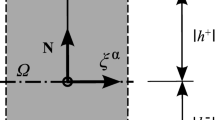Conclusions
In this paper a theoretical approach to multilayered shell and plate analysis based on a kinematical model with six degrees of freedom is presented. The theory has been confirmed by some numerical examples. From these we draft the following conclusions:
-
1.
The theory proposed for laminates can be used successfully also in the case of thin sandwich structures. It seems that the determination of stiffnesses is not so sensitive with regard to the ratios of the elastic moduli.
-
2.
In the case of fibre reinforced laminates the results show a strong dependence not only on the fibre orientation angle, but also on the kind of lamination. These phenomena can be explained by the transformation rules of the local stiffness values. In many practical situations, simplified calculation formulae can be used for the local stiffness.
-
3.
The results based on models with five or six degrees of freedom are very similar to standard situations with a simple geometry. In the cases of complicated geometries a model of six-degree-freedom provides a better agreement with results of there authors.
-
4.
Further investigations should be continued on the effect of shear correction factors (see, e.g. [24]) and new classes of shell problems (stability, failure and inelastic material behavior).
Similar content being viewed by others
References
J. R. Vinson and R. L. Sierakowski, The Behavior of Structures Composed of Composite Materials, Dordrech: Martinus Nijhoff (1987).
V. V. Vasiliev and Yu. M. Tarnopolsky, Composite Materials (Manual), Moscow, Mashinostroenie [in Russian] (1990).
V. V. Bolotin and Yu. N. Novikov, Mechanics of Multilayered Structures Mashinostroenie Moscow [in Russian] (1990).
N. A. Alfutov, P. A. Zinov'ev, and B. G. Popov, Analysis of Multilayered Plates and Shells made from Composite Materials [in Russian], Mashinostroenie, Moscow (1984).
A. K. Malmeister, V. P. Tamuzh, and G. A. Teters, Strength of Polymer and Composite Materials [in Russian], Zinatne, Riga (1980).
Yu.M. Tarnopol'skii, “Composite materials engineering of the USSR,” Mekh. Kompozitn. Mater., No. 5, 787–795 (1991).
J. N. Reddy, A Simple Higher-order Theory for Laminated Composite Plates, Trans. ASME: J. Appl. Mech., 51, p. 175–752 (1984).
T. Lewinski, “On refined plate models based on kinematical assumptions,” Ingenier Archiv., 57, 133–146 (1987).
I. Elishakoff and H. Irretier (eds.) Refined Dynamical Theories of Beams, Plates and Shells and Their Applications Springer, Berlin (1987).
W. Wunderlich, “Vergleich verschiedener Approximationen der theorie dünner Schalen (mit numerischen Beispielen),” Techn.-Wiss. Mitt. des Instituts für Konstruktiven Ingenieurbau der Ruhr-Universitä bochum. 73–1 (1973).
E. Reissner, “Reflections on the theory of elastic plates,” Appl. Mech. Rev., No. 11,38, 1453–1464 (1985).
A. K. Noor and W. S. Burton, “Assesment of computational models for multilayered composite shells,” Appl. Mech. Rev.,43, No. 4, 67–97 (1990).
R. B. Rikards, The Finite Element Method in the Theory of Shells and Plates [in Russina], Zinatne, Riga (1986).
H. Eschenauer and W. Schnell and Elastizitätstheorie II. Mannheim: Wissenschafsverlag (1986).
J. R. Vinson and T. Chou, Composite Materials and Their Use in Structures, London: Appl. Sci. Publ. (1975).
T. Kant, Thick Shells of Revolution, Some Studies. Bombay (1976).
J. N. Reddy and C. F. Liu, “A higher order shear theory of laminated elastic shells,” Intern. J. Eng. Sci.23, No. 3 319–330 (1985).
J. N. Reddy, Analysis of Laminated Composite Structures, Springer, Berlin (Lecurure Notes in Engineering 37) (1988).
E. Hinton, D. R. J. Owen, and G. Krause, Finite Elements Programme für Plattern und Schalen., Springer, Berlin (1990).
T. P. Kant, Doctor-Thesis, Dept. of Civil eng., Indian Institute of Technology, Bombay (1988).
T. Kant, M. P. Menon, “Higher-order theories for composite and sandwich cylindrical shells with C ° finite element,” Computer and Structures,33, No. 5, 1191–1204 (1989).
J. Bühlmeier, Ein Beltrag zur natürlichen formulierung von Plattenund Schalenelementen beliebiger Dicke, Diss. Universität Stuttgart (1983).
O. C. Zienkiewicz, The Finite Element Method, McGraw-Hill, London (1977).
R. B. Rikards, A. K. Chate, and M. L. Kenzer, “Methods of averaging the shear stiffness of multilayered structures in calculating the frequencies according to the timoshenko model,” Voprosy Dinamiki i Prochnosti,52, 176–193 (1990).
Author information
Authors and Affiliations
Additional information
Published in Mekhanika Kompozitnykh Materialov, Vol. 29, No. 4, pp. 500–511, July–August, 1993.
Rights and permissions
About this article
Cite this article
Altenbach, H., Altenbach, J. & Nast, E. Modelling and analysis of multilayered shells based on a timoshenko-type theory with six degrees of freedom. Mech Compos Mater 29, 374–384 (1994). https://doi.org/10.1007/BF00617163
Received:
Issue Date:
DOI: https://doi.org/10.1007/BF00617163



